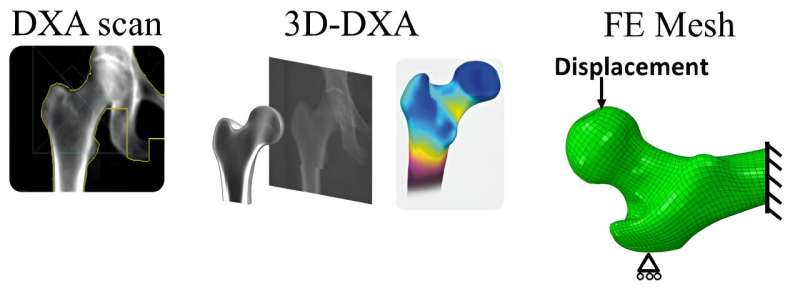This article has been reviewed according to Science X's editorial process and policies. Editors have highlighted the following attributes while ensuring the content's credibility:
fact-checked
trusted source
proofread
New diagnostic tool for femoral osteoporosis improves the efficacy and viability of current methods

Osteoporosis can be detected and prevented more effectively thanks to a new diagnostic tool created by a team made up of researchers from the UPF BCN MedTech unit, the companies 3D-Shaper Medical and CETIR Medical Group, and Hospital de la Santa Creu i Sant Pau.
This public-private collaboration has given rise to the design of a new tool to calculate the risk of fracture due to femoral osteoporosis, from a biomechanics approach—which studies the mechanical structures of living beings such as those that account for the movement of the body—with implementation costs that make its application feasible in clinical practice.
This tool uses statistical methods to generate three-dimensional images of the femur, developed by 3D-Shaper Medical, with biomechanical simulations developed with BCN MedTech (UPF). As a starting point for applying statistical methods, the new tool uses 2D images obtained from the most widespread method for the clinical diagnosis of osteoporosis today (DXA).
It should be kept in mind that currently, the most widespread diagnostic tools are based on two-dimensional images, which do not adequately capture the density of the trabecular and cortical compartments of the bone. This is essential to assess bone strength and prevent possible fractures.
The research behind the new diagnostic method has recently been disclosed in an article published in Journal of Clinical Densitometry.
Why is there a need to improve current methods?
Today, the most widespread method used to diagnose femoral osteoporosis is so-called dual-energy X-ray absorptiometry (DXA). This technique enables determining the mineral density of bone tissue based on the amount of radiation it can absorb. Indeed, osteoporosis is linked to a loss of bone density, which decreases bone strength and increases the risk of fracture.
This method, which yields two-dimensional images, has limitations for determining the volumetric distribution of mineral density—which must be three-dimensional—which is essential to examine bone strength and improve fracture prevention carefully.
Another, more advanced method that is scarcely implemented in clinical diagnosis due to the fact that it exposes patients to higher levels of radiation is quantitative computed tomography (QCT). Tomography scans yield detailed images of different internal regions of the body including bone tissue, also using X-rays, but with 3D reconstructions of bone volume.
Previous studies have shown that this 3D capability of QCT makes it a better-prepared technique for estimating bone strength and fracture risk than the conventional 2D-DXA method. In addition, it allows the translation of volumetric information on bone morphology and quality into mechanical information on bone strength.
However, its use has not been extended to clinical practice, not only because it exposes patients to higher doses of radiation but also due to its high cost and because it takes longer to process images obtained by QCT than 2D-DXA images.
The research proposes an effective and feasible method for clinical practice
The new method is based on 3D dual-energy X-ray absorptiometry (3D-DXA), a technique developed by the team at 3D-Shaper Medical based on the research initiated at UPF before the creation of the technology-based company. Essentially, "the new methodology complements and improves DXA with computational and statistical systems that allow estimating the mineral density of the entire bone volume, as well as obtaining detailed three-dimensional images of its shape."
"It also opens up the possibility of converting this volumetric information into quantitative information on bone strength, based on biomechanical simulations with the finite element method, one of the specialties of the BCN MedTech team," explains Jérôme Noailly, principal investigator in biomechanics and mechanobiology of this UPF research unit.
3D-DXA uses two-dimensional DXA images onto which an added three-dimensional biomechanical simulation is applied. In this way, results equivalent to those of computed tomography can be obtained since volumetric and geometric measurements are translated into femur resistance capacity results of the scanned subject.
The new tool has the potential to improve current diagnoses that are commonly performed using the conventional DXA method, which is not capacitated to detect up to 50% of patients at high risk of femur fracture.
In fact, the research team as a whole has already tested the effectiveness of 3D-DXA to quantify bone esistance, with a study carried out on 157 patients. Their results improve the prospects of achieving the next step: predicting fracture risk based on DXA images.
More information: Muhammad Qasim et al, 3D-DXA based finite element modelling for femur strength prediction: evaluation against QCT., Journal of Clinical Densitometry (2024). DOI: 10.1016/j.jocd.2024.101471




















